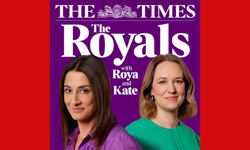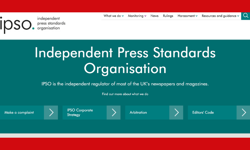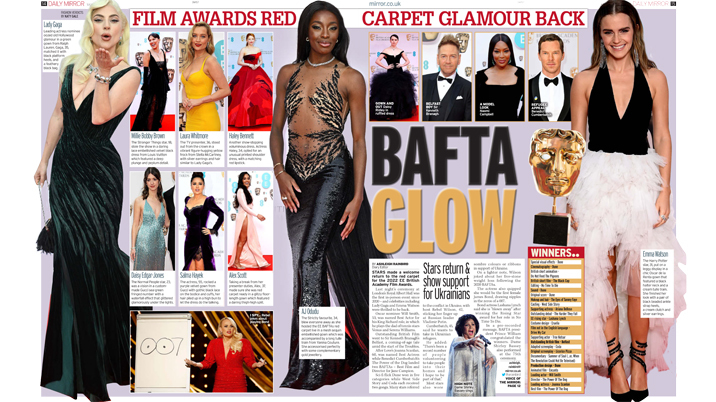
Don’t mention the war
This column is a demilitarised zone. Or intends to be. With apologies to anyone hoping for insight into the past two weeks’ coverage of the horrors in Ukraine, I am deliberately looking the other way. Yes, it’s a dereliction of duty. But some things just have to be done. Someone has to take a good, hard look at what newspapers think their readers want and need to cheer them up. Like Cheltenham, Crufts, the Baftas. The usual staples of this time of year while we’re waiting for the mutant giant rats and this year’s Bake Off line-up.
Let’s start with the Baftas, the precursor of the Oscars that occasionally brings a Hollywood A-lister our way and always provides an excuse for admiring / bitchy assessments of the frock parade. These events tend to follow a pattern: there’s the red-carpet glamour, the host’s risqué jokes, winners’ faux surprise when their name is called out, the tearful acceptance speeches. You know the drill.
Since news is supposed to be the unexpected, you might think there would be journalistic delight when something breaks the mould. But to do so would indicate that you were paying less than full attention to various protests – from hosts, winners or interlopers – down the years. Showbiz reporters and page designers do not like it when players go off script: the spreads are always still full of revealing gold lamé, with the disrupter mentioned in passing downpage or roundly told off for “sparking outrage” further up.
Showbiz reporters and page designers do not like it when players go off script.
But, say a British actress, known for her television appearances, beats an American superstar – and one who has actually bothered to turn up for the event – to a big prize? Surely that would get top billing? We just love British winners, don’t we?
Unless they happen to be 60 and perhaps not quite the right shape for plunge-neck, scoop-bottom flimsy.
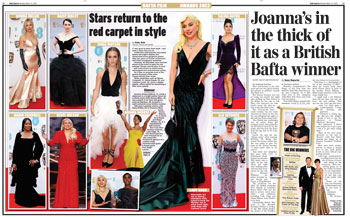
The betting was on Lady Gaga to be named best actress, but the golden mask went to Joanna Scanlan. And only the Express, bless its little cotton socks, grasped the story of the night. Three papers made the Baftas their front-page image, but none went for Scanlan. The Mail had Emma Watson, the Sun Lady Gaga (“All gong wrong for Gaga”), and the Telegraph Benedict Cumberbatch and wife*.
Nor was there room for Scanlan on the Mail or Telegraph inside pages, though the Mail managed another picture of Watson among its 11 featured stars. Metro, with 25 pictures, and the Mirror, with 15, were similarly strapped for space. Scanlan was also absent from the Times and the supposedly right-on Guardian. Only the Express, i, Sun and Star carried photographs of our winner – and in every case as a small square drop-in. Every single paper had a big picture of Bafta-deprived Lady Gaga.
What was the reason for this? Because Scanlan doesn’t conform to the young, slim, glamorous “ideal”? Well, we know from the previously documented adulation of the likes of Helen Mirren and Judi Dench that youth isn’t everything. So it comes down to “ordinariness” or dress size.
Or a feeling that the prize had gone to the wrong person? One paper described Scanlan as being “visibly shocked”, another pointed out that she was not even among the nominations for the Oscars. Kevin Maher in the Times had a whole column moaning that just about all the prizes went to the wrong people and, by inference, he included Scanlan in that. At least he was consistent: in his “who should win, who will win” preview, he had described “best actress” as a nightmare category that ignored everyone who should have been in the running.
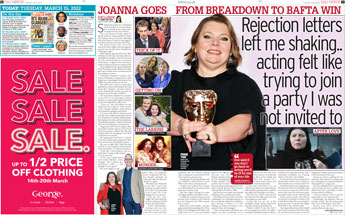
You can imagine the “we wuz robbed” shrieks if a Brit had been stone-cold favourite for an award only for it to go to a little-known American, but nationalism (dressed up as patriotism) does not allow that if the roles are reversed.
And so we are left with this rather unpleasant taste. Rather like A-level students whose good results are clouded by tutting grade-inflation headlines, Scanlan has been given only grudging recognition for her achievement. The Mail caught up the next day with a spread on the “deadpan comic who had the last laugh at 60”, complete with a glowing appreciation of her performance by Jan Moir. So did the Mirror. Its headline was “Acting felt like trying to join a party I was not invited to”. Winning a Bafta should have put such feelings to bed. Instead, it seems to have reinforced the environment that caused them.
Scanlan has been given only grudging recognition for her achievement.
A woman’s place
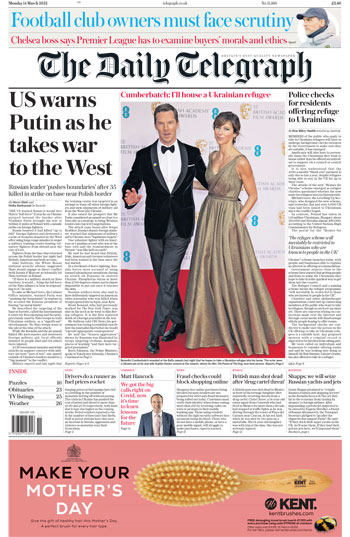
*“Benedict Cumberbatch and wife”? Whatever next? Isn’t this woman worthy of a name check?, I hear you ask. Quite right. Mrs Cumberbatch is the award-winning playwright and director Sophie Hunter. Very much a person in her own right. But that’s not why she was on the front page of the Telegraph on Monday. She was there only because she was on the arm of her husband, in a shimmering dress. The headline above the picture was “Cumberbatch: I’ll house a Ukrainian refugee” when the presumably more accurate “Cumberbatches: We’ll house a Ukrainian refugee” would have fitted. The caption, too, had the husband doing all the doing. “He” hopes to take a refugee into “his” home. Ms Hunter is merely arriving at the awards with him. No wonder she has a mildly bemused look.
This is yet another example of the philosophy “We MUST have a woman’s picture on the front”. On days like today, of course, it is clearly obvious and necessary. You’d have to be an idiot – or the Sun – not to make Nazanin Zaghari-Radcliffe your main image. Everybody else did, but the Sun preferred to puff Cheltenham and Denise Van Outen’s autobiography, which provided a 32-year-old “sex tape ordeal” splash, without even a mention of the Online Safety Bill published today. I can only surmise that it was contractually obliged to lead on Van Outen on the day her book came out, and so our released prisoner was squeezed into a tiny box by the titlepiece. Heaven help us.
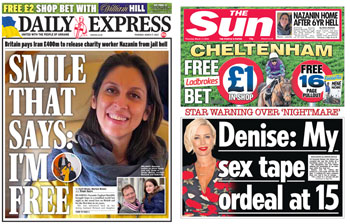
(Incidentally, I’d like to commend the Express among the rest for another uncluttered cover that shows once again that it can do journalism if it tries.)
But I’m talking here about editors demanding a woman’s presence even if she’s not strictly – or even remotely – relevant. The Sun and Star make no bones about why their daily Page One girl is there: to show a bit of flesh. The Telegraph’s approach is often more along the lines of Country Life’s “girls in pearls”; a comely woman in wellies is a banker, especially at weekends, but if there’s no news imperative, just about any portrait of a woman can be made to work as a standalone.
The whitetops both also prefer to see a female presence in their double-column picture slot. For the Express, television stalwarts often fit the bill, while the Mail is more eclectic. And more determined.
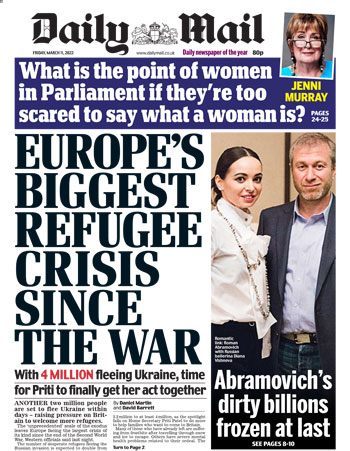
When Shane Warne died, it was inevitable that Liz Hurley would be alongside him on the Mail’s front page. When Roman Abramovich was sanctioned, its front-page photograph had him in the company of ballerina Diana Vishneva. The caption’s kicker was “Romantic link”, but there was nothing to bolster this and Ms Vishneva was not mentioned again in that issue.
Two days later, an inside spread asked “Is Roman dating actress, 25, from Ukraine?” This piece, about a woman called Alexandra Korendyuk and based on speculation from a Russian gossip columnist, also said that he had been “linked to” Ms Vishneva. Maybe Abramovich followers will know all about this maybe relationship, but for the casual reader and the Mail team, she serves her purpose just being a woman photographed with the man of the day.
You really would think that by this stage of the 21st century, this tokenism might have been jettisoned. But instead it seems to be becoming more pronounced. Last Tuesday was International Women’s Day, a day that is supposed to celebrate women’s social, economic, cultural and political achievements and serve as a “call to action” to accelerate women’s equality.
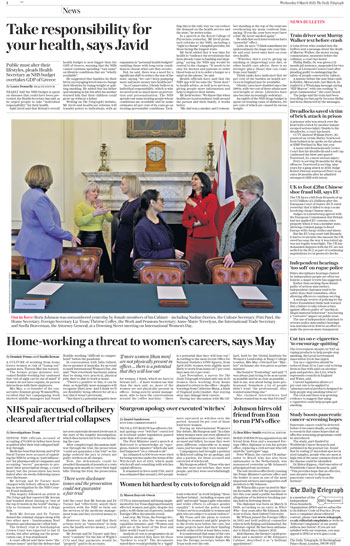
How better, then, to mark the occasion than with a staged photograph from Downing Street, as seen on page 2 of the next day’s Telegraph. “Out in force,” read the caption, “Boris Johnson was outnumbered yesterday by female members of his cabinet, including…” It then listed the six women in the picture – one of whom is not, in fact, in the Cabinet, but does “attend”.
Mr Johnson is, of course, always outnumbered by female members of his cabinet as there is only one of him and there are more than one of them. But he wasn’t on this occasion. Because he wasn’t in the picture. So why it was necessary to mention him at all, heaven knows.
All the allusion to “outnumbering” seemed to achieve was to inspire the question, “yes, but how many men are there?” To which the answer is 17 – nearly three times as many as women. That may or may not be a good thing. People should be appointed for their ability rather than their gender and I’d sack all six of last week’s posers for incompetence (though Liz Truss may deserve a reprieve for getting Nazanin out). But a stunt is a stunt is a stunt. And it doesn’t become less so if it’s done to “mark” an event that is so important to the Prime Minister that he didn’t even turn up for the photoshoot.
Only themselves to blame
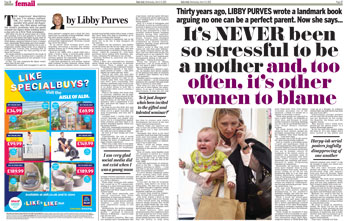
Meanwhile the Mail, a paper aimed specifically at women, continues on its mission to undermine the confidence of its core audience by getting female writers to write “think pieces” that can generate headlines like this one.
Kate to the rescue
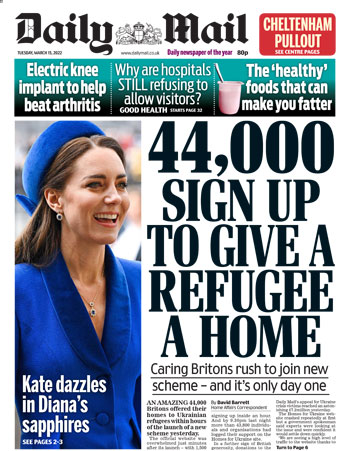
Of course when it comes to distractions from the war and you need a picture of a woman, there is one person you can depend on: Kate.
The Royals are certainly putting in the hard miles in filling newsprint through the travails of Brexit, Covid and now Ukraine. The Queen has not made a public appearance outside of Windsor since October. We saw her last month telling some ambassadors she was finding it hard to move and more recently meeting Justin Trudeau. But there are clear concerns about her health and there must be some very worried people fine-tuning their ambitious plans for her platinum jubilee celebrations. This week, she was absent from the Commonwealth Day service at Westminster Abbey and there is speculation (which is all we ever have, really, about the Royal Family) that she may also be unable to attend the memorial service for the Duke of Edinburgh.
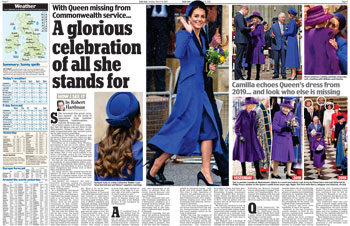
Thank heavens, therefore, for Kate. The headlines on the Commonwealth Day coverage were all about the Queen re-devoting herself to duty and service, but the big pictures were all the Duchess of Cambridge, in some cases creating a strange double-take juxtaposition. We have also seen her on a reading project for children, fretting about what to tell her little princes and princess about the war and “helping out” at a Ukraine charity.
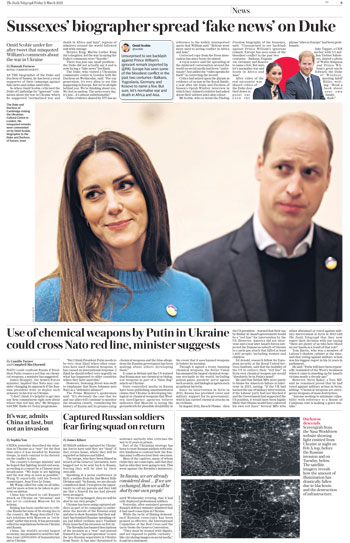
Wills has done his bit here, too, appearing alongside his wife in a full-width photograph in the middle of the Telegraph’s war coverage. This was because a man who wrote a book about his brother had accused him of saying something about the war that he hadn’t said. I’m sure people concerned about refugees or Putin’s military tactics will have been pleased to have seen that record set straight. (The Times did the same, with a not-quite-so-big picture.)
But this column is a demilitarised zone, so let’s get back to the royals and a bit of story / picture counting. Apart from What Katy Did and What Katy Did Next, we’ve had the “whining” Sussexes not coming back for the Philip memorial and Sophie Wessex meeting a woman she had befriended over the phone during lockdown. In total, over the past week, our national dailies have printed 32 pictures of the Duchess of Cambridge, 13 of her husband, 12 of the Queen, eight apiece of Charles, Camilla and Harry, five of Sophie and three of Meghan.
That’s almost as many royal photographs as free bets for the Cheltenham Festival.
The under-reported case of Child Q
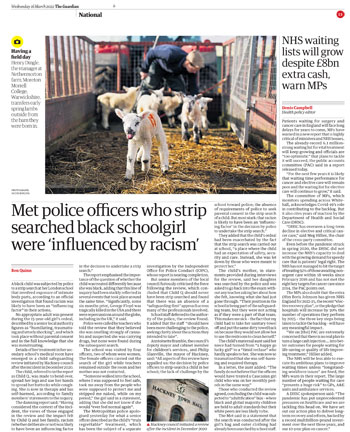
The Metropolitan Police don’t seem capable of getting anything right. The Stephen Port murders, the Daniel Morgan investigation, Sarah Everard’s murder and vigil, Charing Cross sexism and racism, the list goes on and on. And there to document every failing has been the ever-assiduous Daily Mail, never missing a chance to put the boot into Cressida Dick. Which makes it strange that it showed no interest in Child Q yesterday.
A 15-year-old girl was taken out of an exam and strip-searched by police at her Hackney school, with no adult present and without her parents’ knowledge or consent. The girl, who was menstruating at the time, had to expose intimate body parts and was made to bend over, spread her legs and use her hands to part her buttocks. She had been suspected of possessing cannabis, but none was found.
This week, the police apologised after an investigation found that racism was likely an influencing factor in the “humiliating, traumatising and utterly shocking” search. Because the girl was, of course, black.
I was alerted to this story through Twitter. Martin Barrow, a former colleague who pays close attention to child protection issues, picked up the report from Hackney Council’s website on the day it was published. He tweeted it out and describes the response as astonishing: Twitter metrics showed 6.5 million hits on Tuesday, 10 million on Wednesday, 2 million today. The Press seemed less interested.
Another Met Police scandal: a black girl was stripped and searched at school. The search, which involved the exposure of her intimate body parts, took place without an appropriate adult present and with the knowledge that she was menstruating. Case review:https://t.co/mVZgCBwJCD
— Martin Barrow (@MartinBarrow) March 15, 2022
The Guardian and Metro made the story a page lead, the Telegraph a downpage single, and the Times a small double column. The author of that story, Fiona Hamilton, seems to have thought it merited more attention, and her tweet highlighting the case was shared more than 5,000 times. Many of those retweets were further shared thousands of times, so there’s a very good chance that more people will have heard about the case through her social media account than through her paper.
Met Police apologises to black schoolgirl, 15, who was stripsearched while menstruating after teachers smelt cannabis. In breach of guidelines, officers did not get appropriate adult to oversee + mother wasn't told. Review found that search was wrong + racism "likely a factor"
— Fiona Hamilton (@Fhamiltontimes) March 15, 2022
This looks to me like proof that there is sufficient interest in the story to justify press attention, yet only those four papers covered it at all.
Maybe because strip searching black people isn’t that unusual?
I also learn courtesy of Twitter that the Met have conducted about 172,000 strip searches over the past five years, 9,000 of them on children. A third of these strip searches were of black people, which might seem fewer than you’d expect – until you consider that less than 12% of Londoners are black.
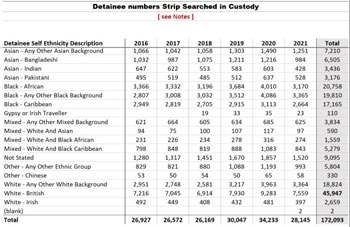
These statistics were published last month by Tom Kemp, a criminology researcher at Nottingham University, after analysing a response to a freedom of information request.
Our newspapers are constantly railing against social media. They also insist that they are not racist. So would it be too out of the way for them actually to be doing – or at least reporting – work like Kemp’s? Or to take notice of egregious individual cases like that of Child Q?
There’s a very good chance that more people will have heard about the case through her social media account than through her paper.
Front page of the fortnight
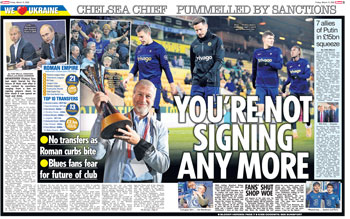
Finally, I’m reneging on my promise of no war. But only a little bit. I just have to commend this visual pun from the Sun on Chelsea’s woes. Much better than the “You’re not blinging” splash in the Metro a couple of days later.
And the front page of the fortnight has to be a war one. Once again, so many strong candidates, but this from the Times is my favourite. It is so clean and the picture of Abramovich looking forlorn and isolated in an airport lounge is so compelling.
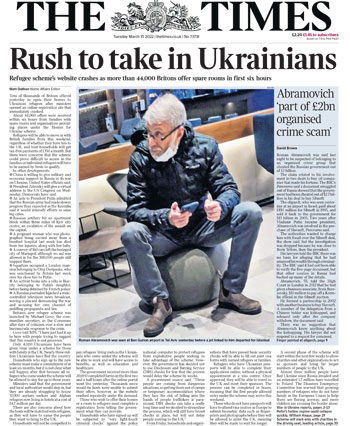
Oh, and PS (still on the war): That splash about the rush to take in Ukrainians was a common theme on Tuesday. More than 44,000 people had offered to take in a refugee in the first hours of Michael Gove setting up his hotline. This was universally interpreted as a sign of Britain’s great humanity and generosity.
But I have as uncomfortable a feeling about that as I do about Boris Johnson’s assertion that we took in more Syrian refugees than anyone else in Europe, when we welcomed 25,000 against more than a million in Germany (The Times’s excoriating leader on this subject on Saturday is worth your time). And, while we’re at it, about the way Gove was allowed to claim that Labour invented the “hostile environment”, when there can’t be anyone who doesn’t know that one lies at Theresa May’s door.
Many people in this country are struggling in poverty or in the fallout from Covid; not everyone has a spare room. But I don’t think 44,000 or 120,000 – the number being put about yesterday – seems that high in a nation of 70 million people. The millions raised by the Mail and Sun’s appeals (the Red Cross is still declining to respond to questions about how much it has received directly) are testimony to the fact that a lot of people have their hearts in the right place. But I tend to think the self-congratulation is premature and do wish we’d lay off the “great” Britain a bit.

Liz Gerard’s Notebook is a fortnightly column published in the InPubWeekly newsletter. To be added to the mailing list, enter your email address here.





